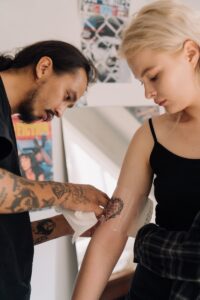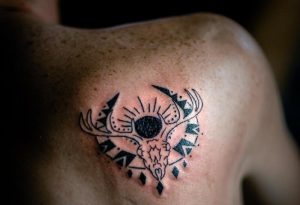Are you a newbie who is just getting inked, and you have been experiencing tattoo peeling and flaking and you’re worried? Yes, tattoo peeling is a natural part of the tattoo healing process and it is completely normal.
However, the peeling process varies and differs from person to person. In most cases, tattoos begin peeling a few days after it has been inked while some tattoos peel later after it has been inked.
You don’t have to panic if your tattoo is peeling. You are probably in the peeling phase and it will surely heal with time.
In this guide, we will be revealing to you everything you need to know about the tattoo peeling process, tattoo healing, tattoo aftercare, and the entire tattoo healing process.
What is Tattoo Peeling?
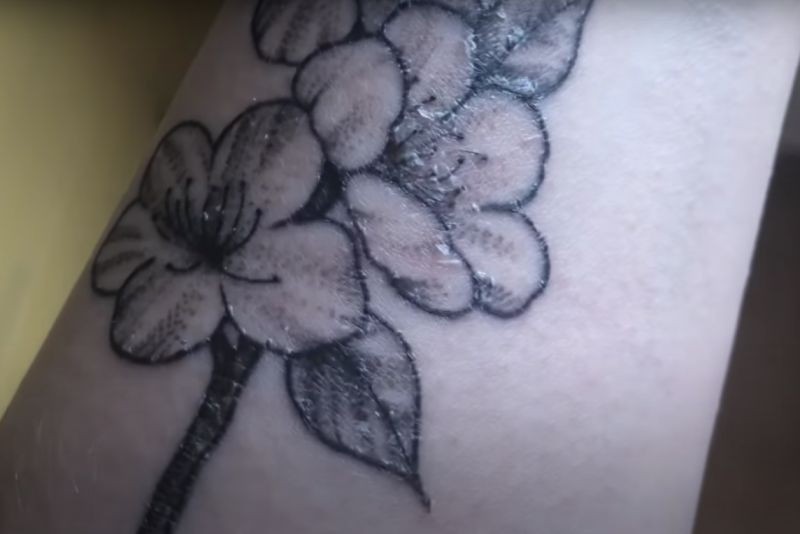
Sometimes, most people do not notice but your new tattoo begins as an open wound. During the tattoo process, needles penetrate your skin thousand of times per minute.
Your skin’s natural response to this trauma is to form scabs over the wound as a protection mechanism. But these scabs won’t usually present themselves like a typical bloody scab you may get from scraping your knee.
Instead, the tattooed skin will harden, forming a protective layer of skin in an attempt to keep potential contaminants out of the wound. This thin, hardened layer of skin will naturally peel and flake off, unveiling a newer, healthier layer of skin.
As your tattoo scabs, the skin underneath it begins to regenerate, forming new skin cells. However, when the scab peels off, it will pull off the dead skin that initially experienced the trauma with it, which can include the topmost layers of your new tattoo! For certain reasons, that is bad.
This can result in a patchy, distorted, and dull design. So for that reason, it’s highly important to take preventative measures to avoid scabbing and mitigate peeling.
When Does a Tattoo Start Peeling?
New tattoos begin peeling towards the end of the first week of healing usually between days 5 and 7, sometimes you may see signs of peeling after only three days.
However, tattoo scabbing and peeling will be slightly different for everyone, but you should be seeing at least the start of the peeling phase beginning by the end of the first week.
Our body sheds around 30,000 to 40,000 skin cells every second without us knowing. When your tattoo starts to peel, you will likely notice it because the skin cells will shed in more noticeably-sized flakes due to the damage caused to the area and surrounding skin.
On smaller tattoos, the peeling can be extremely light, and the area may have already begun peeling without you even knowing. This is much more likely if you’ve been keeping the area well-moisturized. This is because the often dried, flaky characteristics of peeling skin will look much less noticeable.
Is Tattoo Peeling a Normal Process?
Yes, Peeling tattoos are completely normal during the tattoo healing process. Every single tattoo that is inked into an area of skin will cause an open wound that your body will need to protect until it heals. Peeling is an inevitable process and it is totally Normal. So when your tattoo starts peeling, don’t panic.
However, you should be aware that the way your skin peels will always be different depending on tattoo size, the placement of your tattoo, how well you cared for your tattoo, and how heavily the tattoo has scabbed.
Bigger tattoos are always going to peel and flake more due to the larger area of skin that has been distressed by the needles.
Some areas of skin are more resistant to peeling and will peel away at slower speeds than other areas. For instance areas of skin that are constantly exposed to the elements and are used more often will normally take longer to peel because the skin is naturally tougher here, and will shed less frequently.
Sometimes, if you haven’t moisturized your tattoo as much as you should have during the aftercare phase, your skin may dry out and flake away quicker.
How Long Does a Tattoo Peel For?
Tattoos begin peeling after a few days. However, all tattoos peel differently depending on individual situations. Most tattoos will continue to be peeled usually for almost one week.
More so, Tattoos on frequently used parts like the wrist usually take longer to completely peel, but tattoos on more soft and supple areas could be done peeling after just a few days.
Sometimes, tattoos will peel twice, it is normal and when this happens, there is a heavy peeling process, followed by some very light peeling that is sometimes barely noticeable.
This is also normal and nothing to worry about. All you have to do is to keep your tattoo moisturized.
Furthermore, If your tattooed skin contains quite a lot of heavy scabbing, the peeling will naturally be heavier, with larger flakes of skin coming away at once. Similarly, if the tattooed area contains light scabbing, then the peeling skin will be light.
What if My Tattoo Doesn’t Peel?
Sometimes, it seems like the tattoo is not peeling, especially if they are small. However, it could probably be peeling slowly that you might not even observe.
As mentioned earlier, not all tattoos peel at the same time, so yours may just be delayed by a day or two. Fine-line tattoos usually have minimal peeling.
In addition, don’t self-induce peeling by rubbing or scratching at the skin, as this can lead to infection, removal of the tattoo ink, and permanent scarring.
What to Do When The Tattoo Starts Peeling?
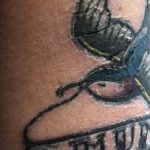
As we all know tattoo peeling is a process of inked skin starting to peel off during the first week or so after getting a tattoo. No one can’t avoid this stage of the tattoo healing process and shouldn’t hinder it, as this could alter your tattoo design!
So to peel the tattoo properly and for better healing here are some points to keep in mind:
Keep Your Tattoo Clean
One of the first things to do in tattoo aftercare treatment is to keep the freshly tattooed area clean while its healing and peeling will prevent potential infections, and will also help to speed up healing by getting rid of dirt and oil from areas that may be blocking pores and slowing down the repairing process.
Don’t Pick and Pull the Scabs
Picking and pulling the scabs is the worst thing to do during the tattoo peeling stage. Sometimes, the peeling skin might look like it is ready to come off, but it will still be attached slightly to the skin, don’t pick the skin, leave it and allow it to naturally fall off.
Why? Because, If you pick or pull at the skin before it’s completely ready, you’re taking the risk of pulling unsettled ink out along with the peeling skin, causing areas of patchiness within your tattoo.
Yes, it can be very tempting to pick or pull the peeling skin, however, endeavor not to pick or pull it, instead allowing it to come off naturally. Picking or pulling it can result in infections, the development of permanent scars, and the removal of the tattoo ink.
Don’t Scratch Your Tattoo if it Itches
Scratching your peeling tattoo can cause your skin to get ripped off prematurely, potentially leading to patchy areas of ink dropout where the ink has been drawn away.
Similarly, during tattoo peeling your skin is very prone to infections and your fingernails will be harboring thousands of germs, and bacteria even if they look clean. Scratching your itching tattoo could turn out to be dangerous and cause an allergic reaction if an infection is caused.
Excessive itchiness can be reduced by applying lotion and getting the tattoo moisturized always. Wait until the tattoo has completely healed before trying to scratch it. And allow it to happen naturally. Excessive peeling and itchiness could be signs of infection, especially if it is accompanied by swelling, fading, painful flaking, shedding redness, oozing, and dry skin.
In severe cases, seek treatment from a medical professional and also do proper aftercare as suggested by your tattoo artist.
Always Use Moisturizer
It is very essential to apply moisturizer to your skin for effective peeling tattoo care, moisturizing your new tattoo help to soothe any itching that you’re suffering from. It also helps your tattoo heal faster as the majority of the moisturizing lotions, petroleum-based products, and ointments contain useful vitamins that promote the healing process.
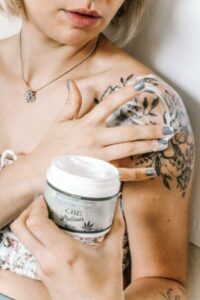
Furthermore, If your tattoo may feel tight as the scabs form, apply lotion or ointments as this can help to bring some elasticity back to the healing tattoo.
In addition, using a good moisturizing lotion during tattoo peeling can help it look better while it’s scabbing and peeling. The dried, flaky pieces of skin will soak up moisture and start to look more like the surrounding areas of healthy skin, camouflaging them somewhat.
While stopping any scabs from drying out and cracking too much, the extra moisture will soak up the flaky pieces of skin so they lie flat against the body so no unsightly chunks of dead skin cells are poking out. Moisture also helps them fall off at the right stage of healing.
This also serves to prevent them from getting accidentally ripped off when brushing against various objects.
Don’t Cover Up Your Tattoo Again
After getting a tattoo, your tattoo artist will bandage your tattoo with a bandage at the early stages, However, once you take off this bandage, don’t cover it up again, as this may slow down the healing process.
Always Wash Your Hands with Antibacterial Soaps Before Touching Your Tattoo
Washing and disinfecting your hands before touching your tattoo can prevent bacteria and other harmful microbes from entering it which can cause infection.
Don’t Wet Your Tattoo for at least 2 Weeks
Avoid swimming, and while taking a bath try to avoid water getting on your tattoo in the shower. This is a very essential tattoo aftercare to follow for your entire tattoo to heal completely. Submerging your tattoo for an extended period can ruin the tattoo design and it can also cause ink fallout as well.
Cover Your Tattoo with Clothing or Sunscreen
Direct sunlight and UV rays are one of the things that affect the healing process of a freshly tattooed area. Always wear long sleeves, long pants, or other loose clothing made of breathable cotton, and wear natural mineral-based tattoo sunscreen which can serve as a protective layer if your tattoo is going to be in sunlight.
Sun exposure can cause bad sunburn, inflammatory skin conditions, allergic reactions, and other complications that can make your beautiful tattoo flare up. More so always wear loose clothing, tight clothing is not advisable.
Be Patient
Truth be told, tattoo peeling is a normal process and there is no way you are going to escape this. Yes, the tattoo is going to look horrid for a week or two. It’s going to look dull and dry, with chunks of skin hanging off.
However, the peeling stage is just a part of the process and there is nothing you can do until the phase has finished and the skin heals completely.
Healing Process — Dry healing or Wet healing?
Dry healing is going through all the aftercare instructions in order to achieve maximum tattoo healing. But in dry healing, you are not using ointment, cream, and lotion on the peeling skin. Instead, you just allow it to heal in the open air.
However, you will agree with me that you still need to keep your tattoo clean by using soap and water and also protect it from tight clothing while it is healing.
More so, the number of people who voted for dry healing is as much as the number who also voted for wet healing. Then who is right?
Yes, both are right. There are advantages and disadvantages to dry healing and wet healing.
Now Let’s dive in.
Dry healing Vs Wet healing
Some lotions and creams contain artificial ingredients that can actually further irritate your skin or cause allergic reactions that interfere with the healing process, including alcohol petroleum lanolin mineral oil, such as vitamin A or D parabens phthalates fragrance.
Some combinations of these ingredients can affect your skin and tattoo ink.
However, Dry healing eliminates this risk completely. But this risk is avoided if you use natural oils or moisturizers like shea butter.
Another concern with dry healing is picking or rubbing the healing area.
Moisturizers can help lubricate the skin and make it less likely that any scraping, picking, or rubbing makes your skin peel and your tattoo heal improperly.
They can also make your skin itch less than with dry healing. If you’re the kind of person who can’t resist scratching anything that itches, you may want to rethink dry healing.
How To Know That Your Tattoo Healing Process Is Going Fine
If this is your first time visiting a tattoo artist, here are some recommendations that you should bear in mind. The healing process is solely dependent on the individual’s body type and skin color.
The skin develops redness around the tattooed area for a few days which is quite normal and will clear out in a few days.
All you need to do is just moisturize and keep adding ointment to avert the presence of an infection.
In the first week, you can use a breathable bandage over the surface of the tattoo.
This is because there are now openings in the skin that was created as a result of the tattoo.
These openings can cause bacterial infection in the individual, which is why it’s recommended that protect the wound from infection by allowing it to breathe well.
FAQs: Tattoo Peeling
Is it Normal if My Tattoo isn’t Peeling?
Don’t bother if your tattoo hasn’t started peeling, however. All tattoos peel and all will heal differently, so yours may just be taking longer to peel or probably might be peeling slowly and you don’t even notice.
Will Peeling Ruin My Tattoo?
Peeling is part of the natural healing process, but excessive peeling can damage the tattoo also. Although it’s important that the person sticks to tips guiding the care of the tattoo and allowing the skin to peel off itself. This is to ensure there are no complications.
Can an Infected Tattoo Still Heal Properly?
No, an infected tattoo can’t heal the normal way.
Will Tattoos be Darker After Peeling?
No, studies show that tattoos don’t darken even after peeling.
Do Tattoos Fade After Peeling?
Truth be told, they don’t. In fact, after peeling, tattoos look more colorful and vibrant.
Is it Normal for the Ink to Come Off a New Tattoo?
It’s completely normal for the ink to come away as a tattoo heals.
Is it Good if My Tattoo Peels or Ink Flakes Away?
Even though it could be alarming, it’s rather normal for your tattoo to flake off.
Does the Tattoo Lose Color When it Peels?
No, Your tattoo shouldn’t lose its color and fade during the peeling phase.
Conclusion
Tattoo peeling is a part of the healing process. It is the process whereby the epidermis (top layer of your skin) is exfoliating. It is because when getting a tattoo, tattooing needles cause open wounds on the skin. In order for the skin to heal, it starts peeling. The tattoo heals differently from individual to individual and also depends on how your skin reacts to the tattoo. However, in order to keep tattoos safe, always follow the tattoo artist’s instructions, and use a paper towel to apply a thin layer of moisturizer when peeling begins. This help to reduce the rate at which the tattoo fades and relieves itch.

